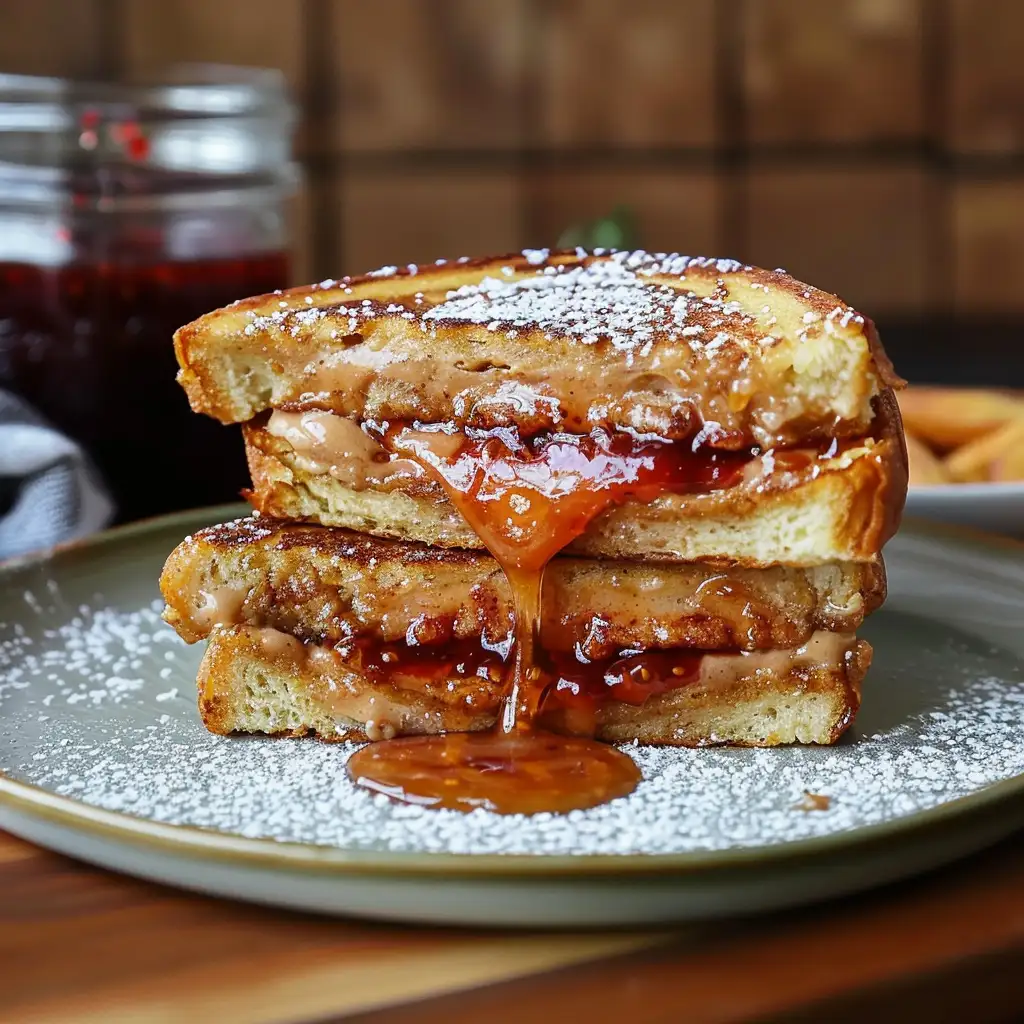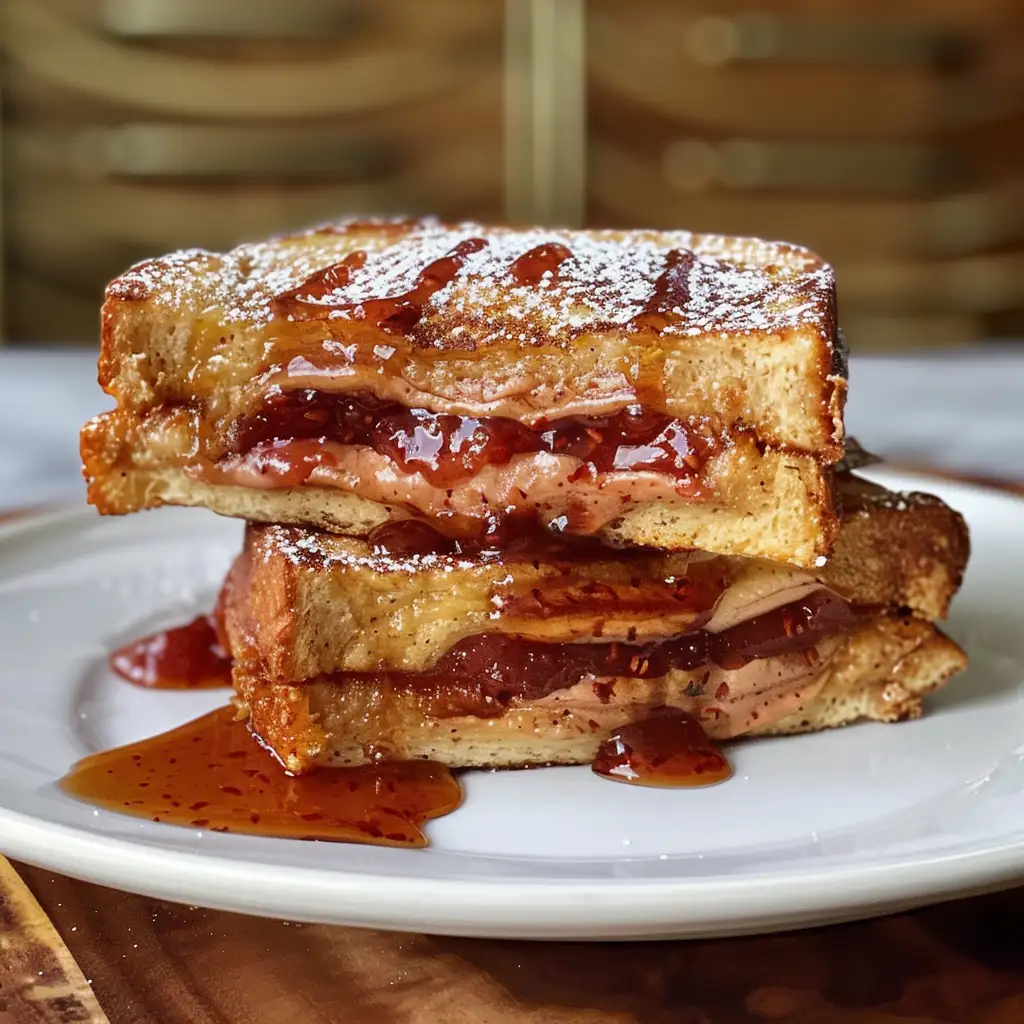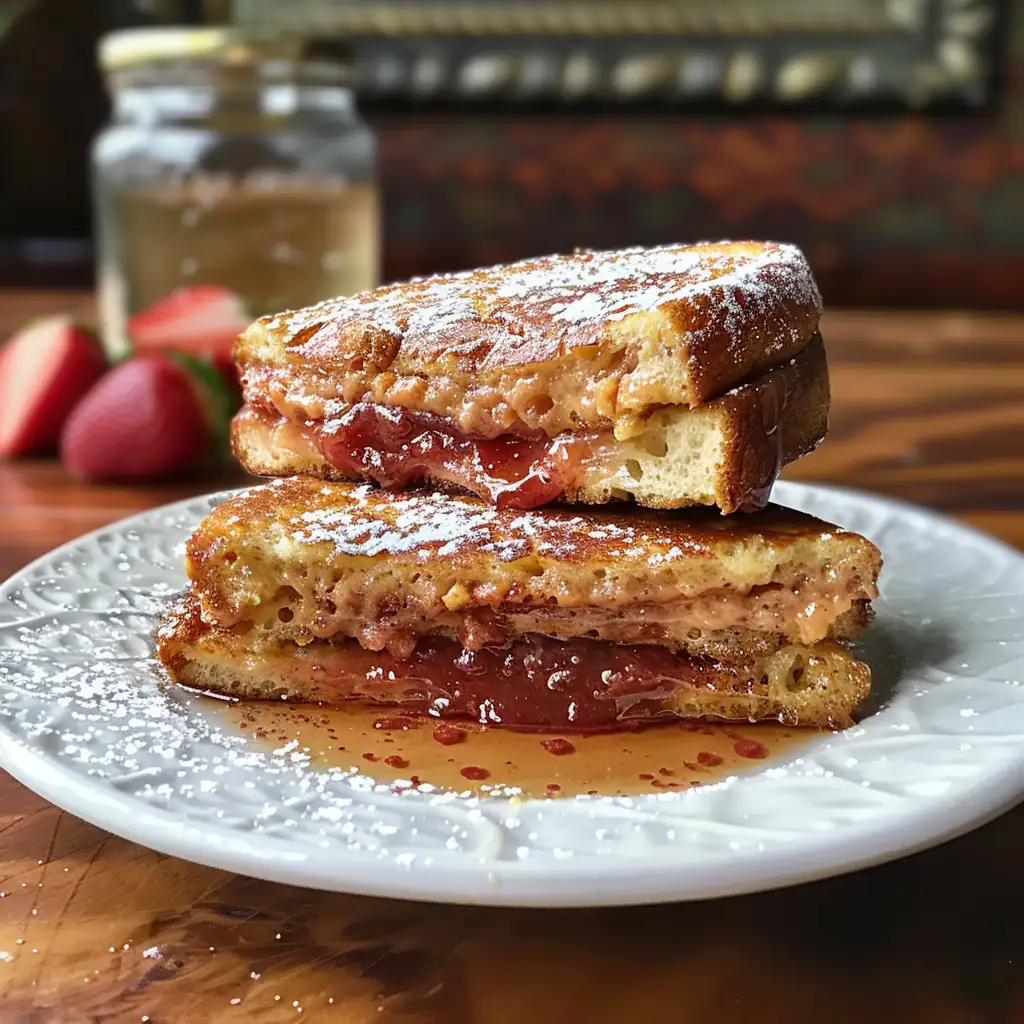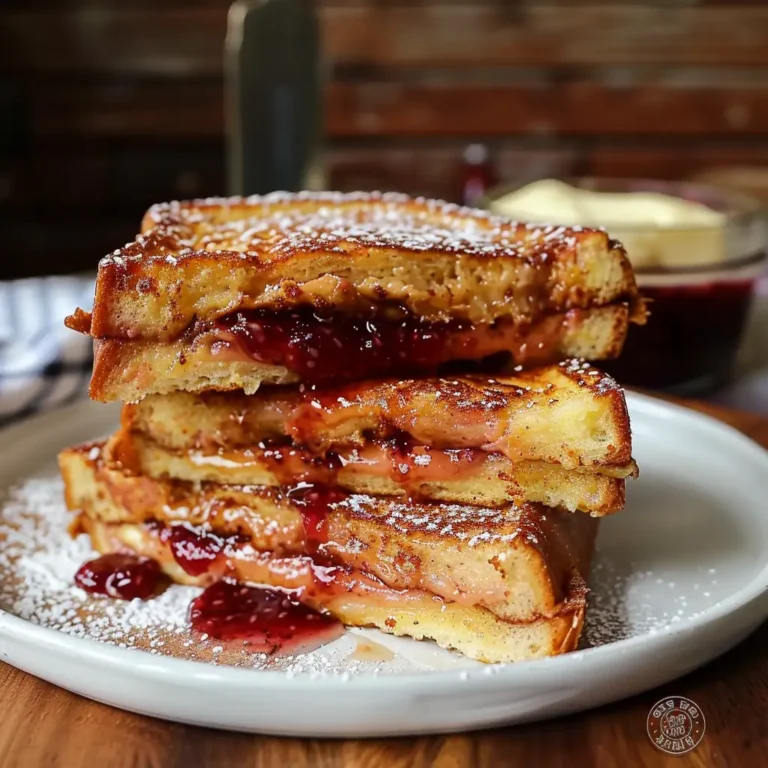Introduction to PB&J Stuffed French Toast
French Toast, a beloved breakfast staple, has a rich history that dates back to ancient times. Originally known as pain perdu or “lost bread,” this dish was a method to rejuvenate stale bread by soaking it in a mixture of milk and eggs before frying. Over centuries, French Toast evolved from a simple, economical recipe to a canvas for culinary creativity, incorporating various flavors and fillings.
The innovation of stuffed French toast introduced a delightful twist to the traditional recipe. By adding fillings between slices of bread before dipping and frying, chefs and home cooks alike could create a myriad of flavor combinations, transforming breakfast into a more decadent meal.
Among the myriad of variations, the PB&J Stuffed French Toast emerged as a crowd favorite. The classic peanut butter and jelly sandwich, a staple in American households, found its way into the hearts of French toast lovers, marrying the nostalgic flavors of peanut butter and jelly with the rich, custardy texture of French toast. This combination not only offers a trip down memory lane but also adds a satisfying complexity to the breakfast plate.
For those interested in exploring the nutritional aspects or seeking alternatives to traditional ingredients, the National Peanut Board provides extensive insights into the health benefits of peanut butter. Additionally, the Celiac Disease Foundation offers valuable information on gluten-free bread options, ensuring everyone can enjoy this delightful dish regardless of dietary restrictions.
The popularity of PB&J Stuffed French Toast is a testament to its irresistible combination of flavors and textures. It stands as a prime example of how traditional dishes can be reinvented to suit contemporary tastes while still celebrating their historical roots.
The Perfect Recipe for PB&J Stuffed French Toast
Creating the ultimate PB&J Stuffed French Toast starts with gathering the right ingredients and understanding the nuances of each step in the preparation process. This recipe not only brings a twist to the traditional French toast but also accommodates various dietary preferences with alternative options.
Ingredients and Alternatives
- Bread: 8 slices of thick brioche or challah bread. For gluten-free options, choose a dense, high-quality gluten-free bread that can hold up to soaking without disintegrating.
- Peanut Butter: 4 tablespoons of creamy or crunchy, based on preference. Almond butter or sunflower seed butter serves as excellent alternatives for those with peanut allergies.
- Jelly or Preserves: 4 tablespoons of strawberry or grape. Feel free to use any type of preserves you enjoy.
- Eggs: 2 large, for the custard mixture. For a dairy-free version, opt for almond milk or coconut milk instead of regular milk.
- Milk: Half a cup, any variety works. Dairy-free milk like almond, soy, or oat milk are great substitutes.
- Vanilla Extract: 1 teaspoon to enhance flavor.
- Butter or Oil: For frying, ensuring a golden-brown finish. Coconut oil is a great dairy-free alternative.

Step-by-Step Cooking Instructions
Preparation of Ingredients
- Begin by laying out all your ingredients. If you’re using gluten-free or dairy-free alternatives, ensure they’re ready to use.
Assembling the PB&J Sandwiches
- Spread a tablespoon of peanut butter on one side of four slices of bread.
- Top the peanut butter with a tablespoon of jelly or preserves on each.
- Cover with the remaining slices to form sandwiches.
Creating the Custard Mixture
- Whisk together the eggs, milk (or dairy-free alternative), and vanilla extract in a shallow dish until well combined.
Frying to Perfection
- Heat a skillet or non-stick pan over medium heat with butter or oil.
- Dip each sandwich into the custard mixture, allowing each side to soak for a few seconds.
- Fry each sandwich until golden brown on both sides, approximately 3-4 minutes per side.
Expert Tips for the Best Outcome
- Choosing the Right Bread: The key to perfect stuffed French toast lies in the bread. Brioche and challah are ideal due to their rich flavor and ability to absorb the custard without falling apart. For a gluten-free version, select a bread that is dense enough to handle the soaking.
- Achieving the Perfect Soak: Ensure the bread is fully coated in the egg mixture but not soggy. A quick dip of about 10 seconds per side should suffice.
- Frying Tips for the Ideal Texture: Use a non-stick skillet or pan and sufficient butter or oil to prevent sticking. Cooking at a medium heat allows the bread to cook thoroughly without burning, achieving a crispy exterior and soft, custard-like interior.
Embracing these tips and techniques will elevate your PB&J Stuffed French Toast to new heights, making it a hit with everyone at the table. Whether you’re adhering to dietary restrictions or simply in search of a delicious breakfast treat, this recipe promises delight with every bite. For more inspiration on creating gluten-free meals, the Celiac Disease Foundation is a valuable resource.
Serving and Pairing Suggestions
Serving the perfect PB&J Stuffed French Toast goes beyond just the dish itself—it’s about creating a delightful meal experience. Here are some suggestions for accompaniments and pairings that will enhance your breakfast or brunch.
Ideal Accompaniments
- Syrups: A drizzle of maple syrup or honey adds a touch of sweetness that complements the savory peanut butter and the tartness of the jelly.
- Fruits: Fresh fruits like sliced strawberries, bananas, or a berry compote can add a refreshing contrast to the rich flavors of the toast.
- Nuts: A sprinkle of chopped nuts such as almonds or pecans provides a crunchy texture and nutty flavor that ties the dish together.
Creative Serving Ideas
- For a visually appealing presentation, stack slices of French toast and garnish with a dusting of powdered sugar, fresh berries, and a mint leaf.
- Serve as part of a breakfast board including various fruits, nuts, and syrups, allowing guests to customize their plate.

Pairing with Beverages
- Coffee: A robust cup of coffee balances the sweetness of the dish with its natural bitterness.
- Milk: A glass of cold milk is a classic pairing, especially for children.
- Fruit Juices: Freshly squeezed orange juice or a berry smoothie can add a tart, refreshing element to the meal.
Nutritional Information and Health Considerations
Understanding the nutritional content and making informed health decisions is crucial when enjoying dishes like PB&J Stuffed French Toast.
Caloric Content and Nutritional Breakdown
- A single serving of PB&J Stuffed French Toast can range from 400 to 600 calories, depending on the ingredients used, such as the type of bread, peanut butter, and syrups.
Making Healthier Substitutions
- Bread: Opt for whole grain or gluten-free bread for added fiber and nutrients.
- Peanut Butter: Choose natural peanut butter with no added sugars or salts.
- Milk & Eggs: Use low-fat milk and egg substitutes to reduce cholesterol and fat intake.
Discussion on Balance and Moderation
- While PB&J Stuffed French Toast is a delectable treat, it’s important to enjoy it as part of a balanced diet. Pairing the dish with fresh fruits and opting for healthier ingredients can make it more nutritious without sacrificing flavor.
- Moderation is key—enjoying this dish as a weekend special rather than a daily breakfast can help maintain a healthy lifestyle without foregoing indulgence.
For more detailed nutritional guidance and healthier substitution ideas, resources like the American Heart Association offer valuable insights into maintaining a balanced diet while enjoying your favorite meals.
Variations and Customizations
The beauty of PB&J Stuffed French Toast lies in its versatility. Here are some ways to customize this beloved breakfast dish with alternative fillings and toppings, along with creative twists that ensure every bite is a new delight.
Alternative Fillings and Toppings
- Nut Butters: Swap traditional peanut butter for almond, cashew, or sunflower seed butter for a different taste or allergy considerations.
- Jams and Preserves: Beyond grape and strawberry, consider raspberry, apricot, or even homemade fruit compotes for a gourmet twist.
- Fresh Fruits: Incorporate slices of banana, strawberries, or whole blueberries inside the toast for added texture and freshness.
- Extra Toppings: Garnish with whipped cream, a sprinkle of cinnamon, chocolate chips, or a drizzle of honey for additional layers of flavor.
Creative Twists on the Classic
- Savory Versions: For those who prefer savory over sweet, try filling your French toast with cream cheese and smoked salmon or ham and cheese.
- Dessert French Toast: Add a scoop of ice cream on top for a decadent dessert, complemented by a sprinkle of powdered sugar and chocolate syrup.

FAQ Section Based on “People Also Ask”
What is the best bread for PB&J Stuffed French Toast?
- The best breads for PB&J Stuffed French Toast are thick, sturdy varieties that can absorb the egg mixture without falling apart, such as brioche, challah, or Texas toast.
Can PB&J Stuffed French Toast be made ahead of time?
- While best served fresh, you can prep the sandwiches the night before. However, soak and fry them just before serving to maintain the best texture and flavor.
How to make PB&J Stuffed French Toast dairy-free or gluten-free?
- For a dairy-free version, substitute regular milk with almond, soy, or coconut milk. Use dairy-free butter for frying.
- To make it gluten-free, opt for gluten-free bread. Ensure that all other ingredients used, like peanut butter and jam, are certified gluten-free.
For those interested in exploring more about gluten-free cooking and ensuring the safety of ingredients, the Celiac Disease Foundation is an excellent resource for guidance and information.

